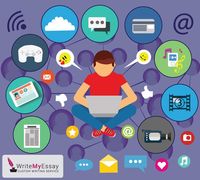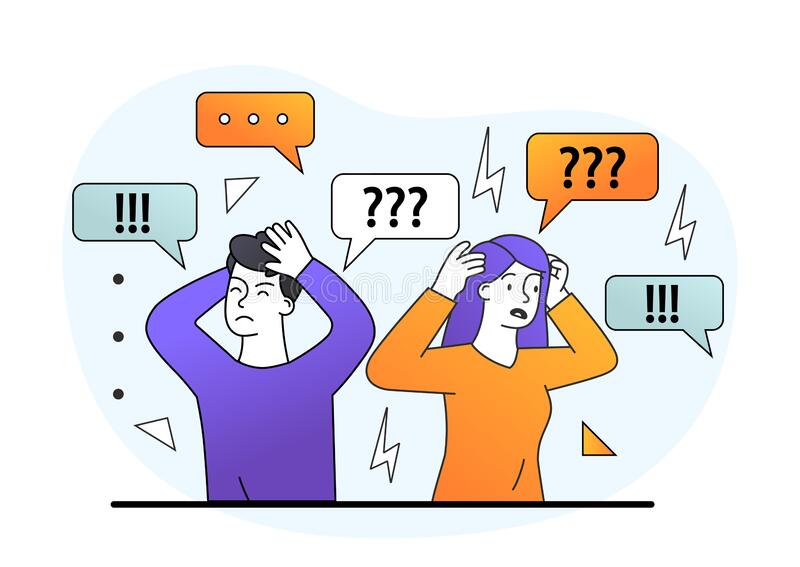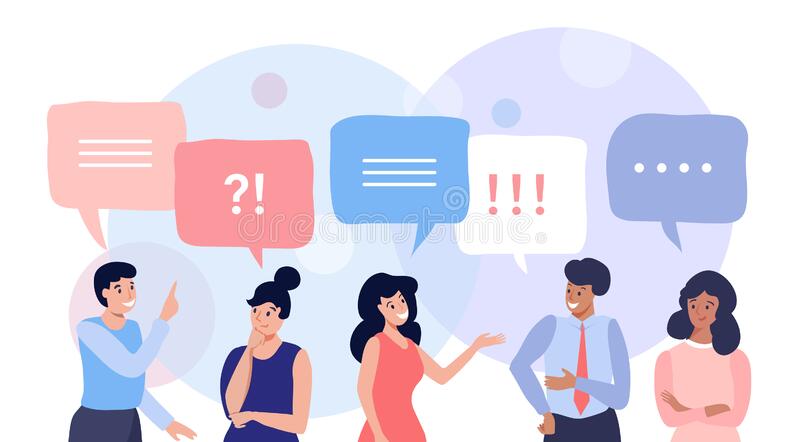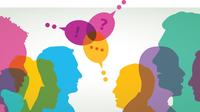Ctrl + F is the shortcut in your browser or operating system that allows you to find words or questions quickly.
Ctrl + Tab to move to the next tab to the right and Ctrl + Shift + Tab to move to the next tab to the left.
On a phone or tablet, tap the menu icon in the upper-right corner of the window; Select "Find in Page" to search a question.
Share UsSharing is Caring
It's the biggest motivation to help us to make the site better by sharing this to your friends or classmates.
Speech Communication
A course enhancing verbal and nonverbal communication skills, public speaking and effective interpersonal interactions for personal and professional success.
verbal
nonverbal
public speaking
rhetoric
persuasion
listening
body language
voice modulation
presentation skills
interpersonal communication
group communication
mass communication
communication theory
speech analysis
speech delivery
The color most remembered on visual aid is:
- Red
- Green
- Blue
- Yellow
Barrier is the factors that affect the flow of _____________.
- Messaging
- Communication
- Sharing
- Information
Which of the following examples can be functions of intrapersonal communication? [Check all that apply]
- Calming yourself down
- Calming yourself down
- Rehearsing your order at a restaurant
- Reminding yourself something
Visual aids such as maps, charts, graphs, and diagrams are called:
- Graphic visuals
- Picture visuals
- Text visuals
- Artistic visuals
When determining a persuasive speech topic, most speakers:
- Analyze the audience before selecting a topic
- _Select a topic, then analyze the audience
- Reject a topic audience members disagree with
- Both a and c
Summarizing the speaker's ideas in your own words is called:
- Plagiarizing
- Establishing a reference
- Making an assumption
- Paraphrasing
Physical context includes all of the following factors EXCEPT...
- Size of the space
- The layout of the space
- Lighting of the space
- Social norms of the space
It is a process of exchanging of information, ideas, thoughts, feelings, and emotions through speech, writing, signals, and behavior.
- message
- essay
- communication
- process
Specific goal is the over- all intent of the speech while general goal is a statement that identifies the desired response a speaker wants from the audience.
- True
- False
- Maybe
- Not Mentioned
A speaker who worries that the audience knows more about his topic than he does is exhibiting the characteristic of trait anxiety known as:
- Dissimilarity
- Speaking history
- Subordinate status
- Communication apprehension
Touch is a form of communication we talked about in class?
- True
- False
It is a Latin word which means “to share” or “to make common.”
- communicare
- comunicare
- comuniccare
- comunicarre
In Interpersonal Communication, the number and purpose of participants determine the particular type of communication.

- True
- False
A statement of fact indicates:
- The speaker will present arguments and evidence to persuade listeners that an idea, object, or person is not good.
- The speaker will use both facts and value judgments to recommend a certain policy or situation
- The speaker will present evidence to persuade the listeners that a debatable point is or is not ture
- The speaker will offer evidence in support of a judgement
1. A speech to ______ asks for intellectual agreement and action of some sort.
- Inform
- Demonstrate
- Actutate
- Convince
During the meeting, two participants are having side comments that makes it difficult for others to focus on the agenda being discussed. What kind of element of communication is being portrayed?
- Noise
Saint Louis College posted an announcement on the SLC Facebook page.

- Public Communication
- Mass Communication
- Intercultural Communication
- Organizational Communication
How many percent of our communication is spent as speakers?
- 70%
It is the person whom the sender is communicating with.
- encoder
- communicator
- teacher
- receiver
Environmental noise refers to...
- physical
Which of the following is not specific objective of a speech to actuate?
- Urge the audience to continue doing something
- Urge the audience to stop doing something
- Urge the audience to agree with your viewpoint
- Urge the audience to never start doing something
Which of the following is NOT a basic function of communication?
- interaction
- making decisions
- understanding our world
- looking down on others
You are talking with your boyfriend/girlfriend about breakup.

- Dyadic Communication
One of the primary differences between informative and persuasive speeches is the speaker's goal
- True
- False
Being the secretary, you were asked by your boss to join a meeting on a proposed project.

- Public Communication
- Organizational Communication
- Small Group Comunication
- Mass Communication
Gillian gave a presentation on the number of children in her state that had no health insurance. She presented three simple steps that could alleviate the problem that would benefit the children, their parents and society. Gillian didn't ask the audience to write their representative and she didn't ask them to make a phone call or donate money. She wanted the audience to know that uninsured children present a problem that was solvable. What type of speech did Gillian give?
- A speech to actuate
- A speech to convince
- A speech to inform
- A speech to demonstrate
Billy gave a presentation on appointing a designated driver. He suggested ideas for people to consider before going out for the evening and recommended that people who do not drink should never start. What type of speech did Billy give?
- A speech to actuate
- A speech to convince
- A speech to inform
- A speech to demonstrate
This is what a speaker considers in preparing a speech (the range of demographic and subject specific differences represented in an audience.
- Demography
- Stereotyped Audience
- Marginal Audience
- Audience Diversity
Which model of communication calls the participants "COMMUNICATORS" rather than senders/receivers?
- Interaction
- Transmission
- Transactional
Which of the following is a type of relationship-maintenance goal?
- Exchanging info
- Presenting yourself as competent
- Gaining compliance
- Checking in
In some cultures it't not acceptable to look another person in the eyes. They consider it rude.
- True
- False
[INTERPERSONAL GOAL] You're trying to convince a friend to join you on the "No Phone Friday" train. Which type of interpersonal goal is this?
- Instrumental; gaining compliance
- Instrumental; exchanging info
- Relationship maintenance; checking in
- Self-presentation; presenting yourself as a luddite
1. Audiences are more easily persuaded when arguments are presented in a_____ way.
- Novel or new
- Impersonal
- Vague
- Unfamiliar
The study of orderly thinking, the sequence and connection of thoughts and ideas as they relate to one another" (Bell, 1990, p.262) is known as:
- Logic
- Assertion
- Evidence
- Credibility
Choose the answer that LEAST describes the reasons to learn good communication skills.
- To work collaboratively with others in the workforce
- For emergency purposes
- To earn a college degree
- To argue with our parents
[INTERPERSONAL GOAL] You attend your cousin's chess competition to cheer them on. Which type of interpersonal goal is this?
- Self-presentation
- Instrumental
- Relationship maintenance
- None of the above
You and your classmates attended a webinar as part of your activity in your Practical Research II subject.

- Organizational Communication
- Mass Communication
- Small Group Communication
- Public Communication
The process of interpreting the encoded message of the speaker by the receiver
- Context
- Encoding
- Decoding
- Barrier
Informative speeches promote a skill-making or doing.
- True
- False
Which of the following is an example of a rule for effective communication:
- The message must be clear
- Sender must deliver the message clearly and concisely
- Receiver must be able to hear and receive the message
- all the above
These are graphic representations of the proposed elements included in the communication process.
- communication models
- organizational structure
- pie chart
- venn diagram
According to Gallup Poll surveys cited in the text, which of the following were rated highest in ethical standards in 2009?
- Journalists
- Stockbrokers
- Nurses
- Insurance salespeople
Which of the following handouts would be most appropriately distributed before or during a speech?
- A list of phone numbers of agencies to contact in crisis situations
- Copies of forms that audience members might use to become organ donors
- A recipe for a food item being prepared during a speech
- A diagram showing how to fold a piece of paper to create an origami bird along with the speaker
"Noise" in communication refers to...
- External disturbances that interfere with communication encounters
- Anything that interferes with a communication encounter
- Anything that annoys the communicators in a communication encounter
- None of the above
Misunderstandings occur in which stage of listening because listeners supply meaning to the messages they have sensed?
- Comprehend stage
- Interpret stage
- Evaluate stage
- Respond stage
Communication connects a person with
- another
Which model of communication focuses on communication within cultural, social, and relational contexts?
- Interaction
- Transmission
- Transactional
The goal of this stage is to understand.
- Evaluate stage
- Receive stage
- Interpret stage
- Comprehend stage
Since this type of speech follows a word-for-word method, you might be tempted to skip practicing the speech.
- Manuscript
- Memorized
- Impromptu
- Extemporaneous
Intercultural Communication is the exchange of concepts, traditions, values, and practices among one's self.

- True
- False
If someone has access to networks of information or "inside knowledge", what sort of power do they wield in a group?
- Information
- Referent
- Legitimate
- Expert
The statement, "the project feels like a winner", is an example of which form of the sensory channel?
- Auditory channel
- Kinesthetic channel
- Visual channel
- Positive channel
Verbal and nonverbal responses to messages are called what?
- Message
- Feeback
- Communication
- Verbal
What is the best way to prove to yourself that most nervousness is only minimally obvious to an audience?
- Pay attention to what you're doing as you speak
- Videotape yourself giving a speech
- Watch the audience for clues
- Speak using small gestures to help make yourself unnoticeable to the audience
When communicating with someone whose in a psychological crisis it's important to:
- not tell them they're wrong
- remain professional and calm
- avoid arguing with them
- all the above
The following filters can affect the listener's perception of the speaker:
- Culture
- Gender
- Technology
- All of the above
The audience in the auditorium were clapping their hands after the performance of the orchestra. What element of communication is featured in the scenario?
- Sender
- _Feedback
- Receiver
- Message
It is the message sent by receiver in response to the message he received.
- message
- sender
- _feedback
- environment
How is listening important to communication?
- [No Answer]
It is helpful to write your speech as if it were written essay.
- True
- False
Method 2 of representing evidence (assertion plus evidence) should be used in all of the following except:
- When time is limited
- When the audience will hear opposing views
- When your audience already knows you
- When your audience has at least some general knowledge of your topic
All of the following are suggested as ways to enhance the credibility of your sources except:
- Use only sources with which your audience is already familiar
- Clearly describe the qualifications of your sources.
- Show some important quality your sources and listeners have in common
- Refute expected criticisms of your sources
Knowing the audience and the occasion is crucial in writing a speech.
- True
- False
When analyzing the audience, you should try to find out these things except
- Demographics
- Attitudes, beliefs or values
- Friendly, neutral, uninterested, hostile
- What they have been doing before your presentation
All of the following types of visuals work well with audiences of 50 or more except:
- Posters
- Slides
- Transparencies
- LCD panels
The responses, reactions, or information provided by the receiver.
- Speaker
- Receiver
- Decoding
- _Feedback
It refers to the idea transmitted by the sender to the receiver

- Message
- Regulation
- Source
- Communication
Group communication... [Select all correct responses]
- Can only occur with people that know each other well
- Includes 3+ people
- Must have established rules
- Focuses on a common goal
The person who gets the message is called the ____________
- Sender
- Channel
- Receiver
- Interpreter
Claudia goes to the doctor's office with her 12 year old daughter. Claudia speaks only German. Her daughter speaks German and English. The doctor needs to explain, to Claudia, how to take her new medicine. Which of the following is the best intervention for the doctor to use in order to communicate this information with Claudia?
- use written material
- use a picture board
- use a licensed medical interpreter
- use her daughter to relay the information
Which of the following is NOT an example of nonverbal communication?
- Screaming a name
- Rolling eyes
- Clapping hands
- Smiling
The following statements describe communication except for one. Which is the odd one out?
- Communication is a process.
- Communication occurs between two or more people (the speaker and the receiver).
- Communication is always shared and spoken.
- Communication can be expressed through written or spoken words, actions (nonverbal), or both spoken words and nonverbal actions at the same time.
The _______ are ideas or information being communicated
- Nonverbal
- Sender
- Messages
- Verbal
It is a process of communication in which it conceptualizes an idea in his mind before he is able to formula and organizes the message.
- message
- sender
- receiver
- environment
When listeners are persuaded, they usually attribute the persuasion to
- The speaker's delivery
- The speaker's use of evidence and logic
- The speaker's use of emotional appeals
- The speaker's trustworthiness
During a presentation, a listener becomes aware of a conversation behind her when someone says something that sounds like her name. Her shifting attention to the conversation is an example of what stage of listening?
- Evaluating
- Receiving
- Interpreting
- Comprehending
It is the response or reaction given by the receiver to the sender of the message

- Regulation
- _Feedback
- Message
- Process of communication
The first step in preparing an informative speech should be
- Research the topic
- Determine the topic
- Organize the main points
- Analyze the auduence
Effective communication skills are only important now, while your in school:
- True
- False
Audience recall is better when _____ visuals are used.
- Technical
- Busy
- Color
- Small
When the speaker or listener is distracted by something in their environment, such as people talking, they are experiencing:
- Internal noise
- Contextual noise
- External noise
- Decoding
It is when communication is used to encourage people___
- Motivation
Using someone else's ideas without giving that person credit for the idea is known as:
- Exaggeration
- Distortion
- Plagiarism
- Embellishment
As a teacher, which of the following description relative to our communication skills should be the most appropriate?
- excellent
- fair
- good
- laughable
A listener's verbal, visual, and vocal responses to a speaker's message are known as:
- The listener's frame of reference
- The speaker's frame of reference
- The topic
- The number of people in the audience
It is when communication is used to control behavior___
- Regulation
To maximize listener' understanding in the comprehend stage, you can try
- To prepare for possible misunderstanding
- To carefully analyse your audience
- To increase your speaking rate
- All of the above
Requires you to commit the speech to memory so that you do not bring your notes when delivering it.
- Manuscript
- Impromptu
- Persuasive
- Memorized
Effective communication involves:
- speaking
- listening
- facial expressions
- all the above
TRUE or FALSE: Experiencing hunger is a type of physiological noise.
- TRUE
- FALSE
Which of the following is most likely to motivate an audience to continue to listen?
- A series of attractive visuals
- An explanation of why the speaker thinks this topic is useful
- A statement about how the audience is likely to benefit from this information
- A statement of the purpose of the speech
Which of the following is the most persuasive method of presenting evidence?
- Assertion plus evidence plus source plus qualifications of source
- Assertion plus evidence plus source
- Assertion plus evidence
- Assertion plus first hand experience
This type of interpersonal communication involves only TWO participants.

- Dyadic Communication
- Small Group Communication
- Public Communication
- Organizational Communication
It is a short paragraph summarizing the research findings.
- Abstract
Which of the following is NOT an obstacle in effective communication?
- Self-image
- Perceptions toward others
- Stuttering
- Noise
An informative speech is meant to do all of the following except:
- Introduce the latest information about a topic
- Deepen your listener's knowledge of a complicated term
- Aid your listeners' mastery of a skill
- Influence choices or opinions
Which of the following are examples of poor listening skills: (choose all that apply)
- looking at the floor while someone is speaking to you
- looking at the floor while someone is speaking to you
- texting on your phone
Which of the following contexts of communication focuses on mental/emotional factors?
- Physical
- Physiological
- Psychological
- Social
A speaker whose persuasive speech topic is "the Need for More Organ Donors" would expect the audience response to be:
- Agreement
- Action
- Understanding
- Ability to do something
It is the final concept of the idea formulated by the sender.
- message
- sender
- receiver
- environment
Type all that applies:The different means of communication are...
- speak
- speak
- non-verbal cues
- write
- silence
According to the text, an attitude poll can be used to help you do all of the following except:
- _Select your topic
- Determine whether you should present both sides of the issue
- Determine arguments and evidence to use
- Determine any specific objections to your position
Speaking without advanced preparation.
- Extemporaneous
- Manuscript
- Memorized
- Impromptu
The following are data-gathering procedure among audience, except
- Survey
- Observation
- Ask a representative
- Deduction
What are the two types of Speech Context?

- Intrapersonal and Interpersonal Communication
Which of the following is NOT a type of interpersonal goal?
- Relationship-maintenance
- Social-presentation
- Instrumental
- Self-presentation
A speaker gives a speech about how to take better vacation photographs. The main points of the speech are what equipment to use, how to compose a shot involving only landscape, and how to compose a shot including people. The speaker's visuals include two different kinds of cameras, several lenses, and several enlarged photographs on transparencies, which show good and bad examples of composition. This speech is best categorized as:
- Informational
- Persuasive
- Indirectly persuasive
- Demonstrative
Demonstration speeches promote understanding-knowing.
- True
- False
The ancient orators conceptualized speechmaking following this process: 1) invention, (2) arrangement, (3) style, (4) delivery, and (5) memory—have also withstood the test of time.
- Public Speaking
- Rhetoric and Oration
- Rhetorical Elocution
- Rhetorical Canons
According to research cited and pictured in the text, the visual and vocal codes account for ____ of the meaning of the message.
- 31%
- 50%
- 69%
- 75%
The speaker is expected to be friendly and relaxed, but still courteous during the speech delivery.
- Entertainment
- Informative
- Persuasive
- Memorized
Research on memory has shown all of the following except:
- Speakers should use pictures of some sort on text visuals
- Even poorly designed visuals improve memory
- Recognition memory for pictures is almost limitless
- Listeners remember visual images better than printed words
Effective speakers do all of the following except:
- Use tact, allowing the audience to retain feelings of self-worth
- Distort facts on visual aids to prove a point
- Avoid exaggerated or embellished facts
- Express ideas in a clear and easy-to-understand manner
This communication is carried out with the aid of media technology.

- Dyadic Communication
- Public Communication
- Mass Communication
- Intercultural Communication
Isocrates, who was a Greek contemporary of Plato and Aristotle:
- Possessed an impressive speaking voice that could be hear by large crowd
- Suffered from speaker anxiety and had a voice that would not project
- Had no impact on the study of public speaking
- Started an unsuccessful school of rhetoric
The key component of unintentional plagiarism, as demonstrated by its inclusion in every example of plagiarism, is:
- Not citing the source you use, regardless of whether or not you paraphrase the information or use it word-for-word
- Paraphrasing information from a source to use in your speech
- Taking information word-for-word from a source to use in your speech
- Using information from any online site or blog to use in your speech
A speaker gives a speech about how to distinguish antique jewelry from reproductions. The piece of jewelry that most clearly illustrates her point is obviously too small for the audience to see from the front of the room. What should the speaker do?
- She could pass the piece of jewelry around during the speech
- She could make a larger model of the jewelry
- She could just describe it as well as possible and forget about having a visual aid
- Any of the above would be equally effective
Understanding and developing effective communication skills is helpful now, as a student, and will be helpful later in life:
- True
- False
Which of the following is the least persuasive method of presenting evidence?
- Assertion plus evidence plus source plus qualifications of source
- Assertion plus evidence plus source
- Assertion plus evidence
- Assertion plus first hand experience
In today's world, most persuasive writers combine which types of persuasive issues?
- Fact and value
- Fact and policy
- Policy and scope
- Scope and fact
Using the formula in the text, what is the maximum number of visuals suggested for a 10 min speech?
- 4
- 5
- 6
- 10
A speaker gave a speech about the effects of second-hand smoke. As a result, three audience members chose not to smoke when in the company of non-smoking friends. The speech would be best categorized as:
- Purely informational
- Purely persuasive
- Indirectly persuasive
- Demonstrative
When Mrs. Legate lectures over notes, who is the sender?
- The students
- Mrs. Legate
- The notes
- Mr. Brahmer
Assertive speakers are those who share honest expressions of his/her own feelings, needs and wants while respecting those of others:
- True
- False
Which model of communication focuses on ONE-WAY communication?
- Interaction
- Transmission
- Transactional
In public speaking, it is the composite of you (and your knowledge and intentions), the audience (and their knowledge and expectations), and the occasion (setting, purpose, and constraints).
- Rhetorical Canons
- Rhetorical Situation
- Rhetorical Context
- Rehtorical Exigency
Which of the following could be an example for channel?
- The sender
- Soundwaves
- The receiver
- A smirk
The humorous speeches of comedians and performers are the best examples of this type.
- Persuasive
- Entertainment
- Informative
- Manuscript
The focus of an informational speech is all of the following except:
- Aiding in the mastery of a skill
- Increasing awareness about the latest information on a topic
- Promoting understanding of a difficult concept
- Promoting understanding of an unfamiliar term
The Philippine President Rodrigo Roa Duterte said on Monday, July 27, 2020 to the public that being in alliance with China keeps us safe from any war and conflict. What is the receiver used in the situation?
- President Duterte
- China
- Philippines
- Public
Choose ALL the appropriate ways to overcome the communication barrier of a person with aphasia/speech impediment:
- encourage them to take their time
- encourage them to take their time
- ask short answer questions
- speak slowly and clearly
Which of the following is the best worded purpose statement for a five-minute speech?
- I want to explain to my audience the best way to train a dog
- I want to explain to my audience the best way to train a dog to heel
- I want to show my audience the best way to train a dog to heel
- After hearing my speech, my audience will know how to train a dog to heel
Communication involves the following elements:
- sender
- message
- receiver
- _feedback
- all the above
A speaker's credibility depends less on logical proof and more on:
- The listener's perception of the speaker
- The listener's understanding of the topic
- The speaker;s ability to provide supporting material
- The listening abilities of the audience
Aim to change their perception and convince them that your argument is more important, practical, attainable, or feasible.
- Informative
- Entertainment
- Persuasive
- Impromtu
You presented your section in an Oratorical Speech.

- Mass Communication
- Dyadic Communication
- Small Group Comunication
- Public Communication
Your primary goal is to influence the thoughts, feelings, actions, and behaviors or attitudes of your listeners.
- Informative Speech
- Persuasive Speech
- Manuscript Speech
- Entertainment Speech
What is the conceptual framework of communication?
- [No Answer]
______________ are the means used to send messages during communication
- Messages
- Channels
- Communication
- Nonverbals
You and your bestfriend are talking about your celebrity crush.

- Dyadic Communication
- Small Group Communication
- Mass Communication
- Intercultural Communication
It's important when you're communicating with someone to not send mixed messages. A mixed message is when your words say one thing but, your body language says another:
- True
- False
Examples of effective listening skills include:
- eye contact
- facing the person who's speaking
- asking questions
- all the above
It refers to the one who develops the message to be communicated to either internal or external parties____
- Source
How might our relationships with others affect our communication?
- [No Answer]
People learn the language by studying formally in school or informally on their own. This is a process of ______.
- Second Language
- Target Language
- Language learning
- Language Acquisition
On this type of Interpersonal Communication, Speaker addresses many Listeners.

- Small Group Communication
- Mass Communication
- Public Communication
- Intercultural Communication
How many percent of our active hours is spent in communicating?
- 60%
You and your family are talking about school matters over dinner.

- Dyadic Communication
- Small Group Communication
- Organizational Communication
- Intercultural Communication
According to the text, all of the following are true of using method 4 (assertion plus first-hand experience) to present evidence except:
- You can use it even if you are unknown to your audience
- You can use it if the opposing view will be presented, but you should probably combine it with method 3
- You should not use it unless you have considerable first0hand experience and are more knowledgeable of your topic than most people in the audience
- You should not use it if the audience already perceives you as credible
Which of the following is a barrier to communication?
- Deafness
- Blind
- Aphasia
- All the above
Listeners who sit perfectly still are:
- Listening attentively
- Disagreeing with the speaker
- Daydreaming
- Agreeing with the speaker
In this stage of listening, listeners supply meaning to the messages that they have seen, hear, and felt.
- Interpreting stage
- Responding stage
- Evaluating stage
- Receiving stage
A type of visual aid that makes speakers appear less prepared is a:
- Markerboard
- Object
- Flipchart
- Handout
Which is NOT a preparation step for informative speaking?
- Analyze potential audience
- Research topic
- Research speech
- Memorize speech
Listener interpretation and evaluation often depend on the speaker's:
- Verbal code
- Visual code
- Vocal code
- All of the above
The process of listening has five primary stages: receiving, _______, interpreting, evaluation, and responding.
- Comprehend
- Responding
- Accounting
- Accepting
It hinders the participants of the communication process to understand one another

- Encode
- Noise
- _Feedback
- Motivation
Charlie uses Facebook to disseminate information to his colleagues. What element of communication is Facebook on this situation?
- Speaker
- Noise
- _Feedback
- Channel
What are some examples of psychological noise?
- [No Answer]
Type all that applies:Functions of communication are...
- connect one person with another
- connect one person with another
- develop high mental processes
- regulate speech
- serve as a factor in cultural or heritage preservation
It means to translate a language into and idea

- Noise
- Communication
- Decode
- Source
According to research, the best speaking rate to stimulate audience listening is:
- 100-175 words per minute
- 175-225 words per minute
- 275-300 words per minute
- 400-800 words per minute
Social context refers to both the stated rules and the...
- Unstated norms
- Relationships of communicators
- Identities of the communicators
- Mood of the space
If someone is a subject matter expert (e.g. a professional), what sort of power do they wield in a group?
- Information
- Referent
- Legitimate
- Expert
The factors that affect the flow of communication.
- Barrier
- Context
- Message
- Speaker
The best time to distribute handouts is:
- Before the speach
- After the speech
- During the speech
- As the next speaker begins speaking
It is a medium used to send the message.

- Drama
- Decode
- Source
- Channel
In this stage of listening, listeners judge the speaker and the message.
- Interpreting stage
- Responding stage
- Evaluating stage
- Receiving stage
Speech about objects or people, speech about processes, speech about events, and speech about concepts.
- Persuasive
- Entertainment
- Manuscript
- Informative
Which of the following is not a basic stage of listening?
- Receiving
- Interpreting
- Evaluating
- Observing
The person who gives the message is called the __________
- Sender
- Provider
- Receiver
- _Feedback
You are deciding what course to take in college.

- Intrapersonal Communication
A demonstration speech always takes less time than an informational speech.
- True
- False
It refers to the delivering of message without the use of words.
- lexical
- elements
- non-lexical
- gestures
_____ occurs when fewer people agree with the speaker at the end of the speech than before the speech.
- Persuasive inconsistency
- The boomerang effect
- Credibility effect
- Illogical persuasion
When giving a demonstration speech, you should merely tell the audience how to do something, but never attempt to actually show them.
- True
- False
It is an assumption that all members of a group have similar knowledge, behaviors, or beliefs simply because they belong to that group.
- Marginalizing
- Assumption/Conclusion
- Stereotyping
- Audience Demography
The Department of Public Works and Highways (DPWH) Secretary is making a progress report on a street improvement project that has been going on for two years. Members of the audience are reacting negatively that the project has taken so long. Who is the source in this situation?
- Members of the audience
- DPWH Secretary
- Project
- Report
_____________ refers to the interaction of members along the links of its structure.

- Organizational Communication
Who said this, “The audience is the end and object of the speech.”
- Aristotle
1. When practicing for a demonstration speech, you should add _______ on to your practice time.
- 3 minutes
- 5 mintues
- 1 minute
- Nothing
The power from charisma or likeability of the group member is...
- Legitimate
- Referent
- Coercive
- Reward
Active listening involves:
- asking questions
- repeating back what the other person said
- making eye contact
- all the above
The belief that you are the only person experiencing nervousness is a characteristic of trait anxiety known as:
- Dissimilarity
- Speaking history
- Subordinate status
- Low self-concept
In this stage of listening, listeners select or ignore one or more stimuli from the multitude of stimuli that continually bombard us.
- Interpreting stage
- Responding stage
- Evaluation stage
- Receiving stage
In speech, context refers to:

- person speaking
- situation/event/occasion
- person/s being addressed/spoken to
- All of the above
The power that flows from an appointed/elected position is..
- Legitimate
- Referent
- Coercive
- Reward
Communication involves conveying a message from one person to another through:
- writing
- speech
- tone of voice
- all the above
Delivered with the help of short notes and a clear outline.
- Memorized
- Manuscript
- Impromptu
- Extemporaneous
It means to translate an idea into language___

- Encode
The brain as a social organ means that...
- only humans can communicate.
- the brain can cope with things around it.
- the brain functions best when communicating with its environment.
- humans have brains.
Which organizational pattern is used most often in informative speeches?
- Chronological
- Geographical
- Topical
- Causual
During a speech, the speaker should never give nonverbal cues
- True
- False
According to the text, a narration or story has two important qualities:
- Factual and concise
- Probability and fidelity
- Technical and reliable
- Complex and truthful
You are facing the mirror and deciding what to wear for an important event.

- Dyadic Communication
- Intrapersonal Communication
- Interpersonal Communication
- None of the above.
The sending and receiving of wordless messages is called _________
- Verbal
- Communication
- Nonverbal
- Texting
The following are examples of Intrapersonal Communication except:

- talking in front of the mirror
- consulting advice to a friend
- berating oneself
- reviewing
It was the primary means by which to conduct business, debate public issues, make public decisions, and gain and maintain power.
- Small Group Communication
- Public Speaking
- Oratory and Rhetoric
- Rhetorical Canons
Coercive power is the power to dole out...
- negative incentives
This is the careful crafting of specific speech goal statement because it lays the foundation for organizing your speech.
- Writing a Speech Goal Statement
- Articulating the desired audience response
- Evaluating Information Sources
- Phrasing a Specific Goal Statement
Listeners mentally evade persuasive messages that cause them discomfort by:
- Deliberately misunderstanding the speaker's message
- Hearing only the parts of the message they can deal with comfortably
- Changing the focus of the message so that is doesn't seem to apply to them
- All of the above
Communication that uses words, either oral or written, is ____________
- _Feedback
- Channel
- Sender
- Verbal
All of the following are considered part of the speech environment except:
- The time of day
- The location
- The topic
- The number of people in the audience
When Mrs. Legate lectures over the notes, who is the receiver?
- Channel
- Trump
- The students
- Mrs. Legate
When referring to quantity or scope, which question is significant?
- Does evidence of harm exist?
- Does the problem violate basic societal goals or values?
- Is action or change required?
- Is the problem great enough to make it a social issue?
In an International Youth Camp, you and your newly-met friends suddenly talked about how you celebrate marriage in your own countries.

- Small Group Communication
- Small Group Communication
- Public Communication
- Intercultural Communication
Communication is defined as: the exchange of information, feelings, thoughts, or ideas.
- True
- False
This type of Interpersonal Communication is intended for studying an issue and coming up with a solution.

- Formal Communication
- Frozen Communication
- Organizational Communication
- Small Group Communication
It is the exchange of information by speech, signals or writing___
- Communication
Research into listeners' response to the use of logic and evidence indicates all of the following except:
- Listeners have very little difficulty spotting illogical messages
- Listeners who are not personally involved in the topic are persuaded by large amounts of evidence
- Listeners appear to be persuaded by logical sounding phrases
- Listeners who already favor a speaker's proposal rate the speech as high in evidence even if no evidence is presented.
Factual statements and opinions which support the logical arguments of a speech are known as:
- Logic
- Reasoning
- Evidence
- Assertions
Which of the following is an example of SEMANTIC noise?
- Being distracted by a headache
- Not understanding a word in another language
- Ringing in your ears
- Not hearing your friend over the sounds of traffic
Baldo went to a gift shop and asked the sales lady if they have a big teddy bear because he will be attending his classmate’s eighteenth birthday. The sales lady told Baldo that they do not have the item. In the situation, which conveys the feedback element of communication?
- Buying a gift for a party
- Baldo going to a gift shop
- The sales lady greeted Baldo.
- The sales lady told Baldo that they do not have the item.
Choose ALL the interventions you would use in order to communicate with a patient who is deaf:
- use writing material
- use writing material
- use sign language
- use braille
- face them so they can read your lips
[Check all that apply] Cultural context includes various aspects of identities, including...
- Nationality
- Nationality
- Class
- Gender
- Ethnicity
Which model of communication focuses on communication within PHYSICAL and PSYCHOLOGICAL contexts?
- Interaction
- Transmission
- Transactional
Using a color and underlining on your speaking notes will distract you during your speech.
- True
- False
_______________ is the process of using messages to exchange meaning
- Communication
- _Feedback
- Message
- Receiver
Which of the following is an example of nonverbal communication?
- Thumbs Up
- Saying hello
- Calling your dog
Visual aids that normally include only printed words are called:
- Graphic visuals
- Picture visuals
- Text visuals
- Artistic visuals
To keep up this site, we need your assistance. A little gift will help us alot.
Donate- The more you give the more you receive.
Related SubjectCommunicative Strategies
Communication
Purposive Communication 2
Purposive Communication
Speech Communication 2
Oral Communication in Context
Professional Salesmanship
English as a Second Language
Teaching English in the Elementary Grades: Language Arts
Mass Communication
Principles of Communication Systems
Show All Subject
Affiliate Links
Shopee Cashback Voucher
Temu $0 Shipping Fee
Amazon 75% Off Discounts